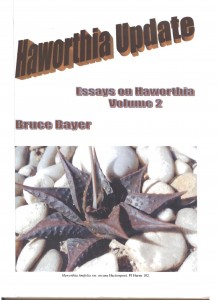This problem of continuity is one I seem to have difficulty in conveying to my readers and listeners. The difference between one species and another is a discontinuity and, if we believe in evolution, it is the resultant of a break-up of continuity in its ancestral parent species. The “model” we have in our minds, is of progressive change from one recognisable entity to another by evolution. Geographic distribution and re-distribution are key elements in this process. But we do not seem accept this in the way we try to classify plants or interpret classifications. Apart from recognising that change could be gradual and therefore manifest continuity, the change may be from a complex variable system which contains different levels of continuity within itself, and not from a simply understood uniform ‘ancestor’.
The result is that in a genus like Haworthia, which is by no means exceptional, the differences between species i.e. the discontinuities between “species”, may be very difficult to either recognise or rationalise. It in fact becomes a statistical operation in which all the characters should be involved i.e. multiple variate analysis. If all the characters could be measured and quantified it is statistically possible to subject all the data so obtained by one of several statistical methods to measure “distance” and “significant difference” between groups of plants which we want to ascertain are species, varieties or even just hybrids. The process of “cladistics” is the use of a system to generate a branching “tree” of relationships base on characters which are also evaluated and loaded for chronological priority (primitive versus advanced). In using such a mathematical package, it is pretended that the classification becomes “objective” and hence replicable to satisfy the scientific requirement. In my estimation, the cladistic process assumes that a two-dimensional “tree” adequately represents the spatial and temporal changes of evolutionary processes, and it does not work.
Somebody might one day try to apply such methods to Haworthia and I say “Good luck to you”. My experience of characterisation and variation in the biological systems I have experience of, and including Haworthia, suggest to me that sensible, practical, experienced “eye-balling” will prove the better bet. Ultimately in Haworthia, I expect that technology and cladistic methods will be testable on the result of my classification. This is not a conceited and arrogant claim. It is a simple reflection on what classification actually is and what it is for. Much of botanical classification has been done by amateurs with no, or minimal, specific training and qualification for that field at all eg. G.W.Reynolds, L.C.Leach, T.L.Salter, J.Lavranos, C.L.Scott, G.G.Smith, M.B.Bayer etc. Their classifications form the basis of many scientific observations, sometimes by scientists who have no conception of the significance, or insignificance of the names they use or what they may actually mean. The classifications may have little to recommend them except the fact that they appear to conform to the approved nomenclatural style.
Continue reading →


